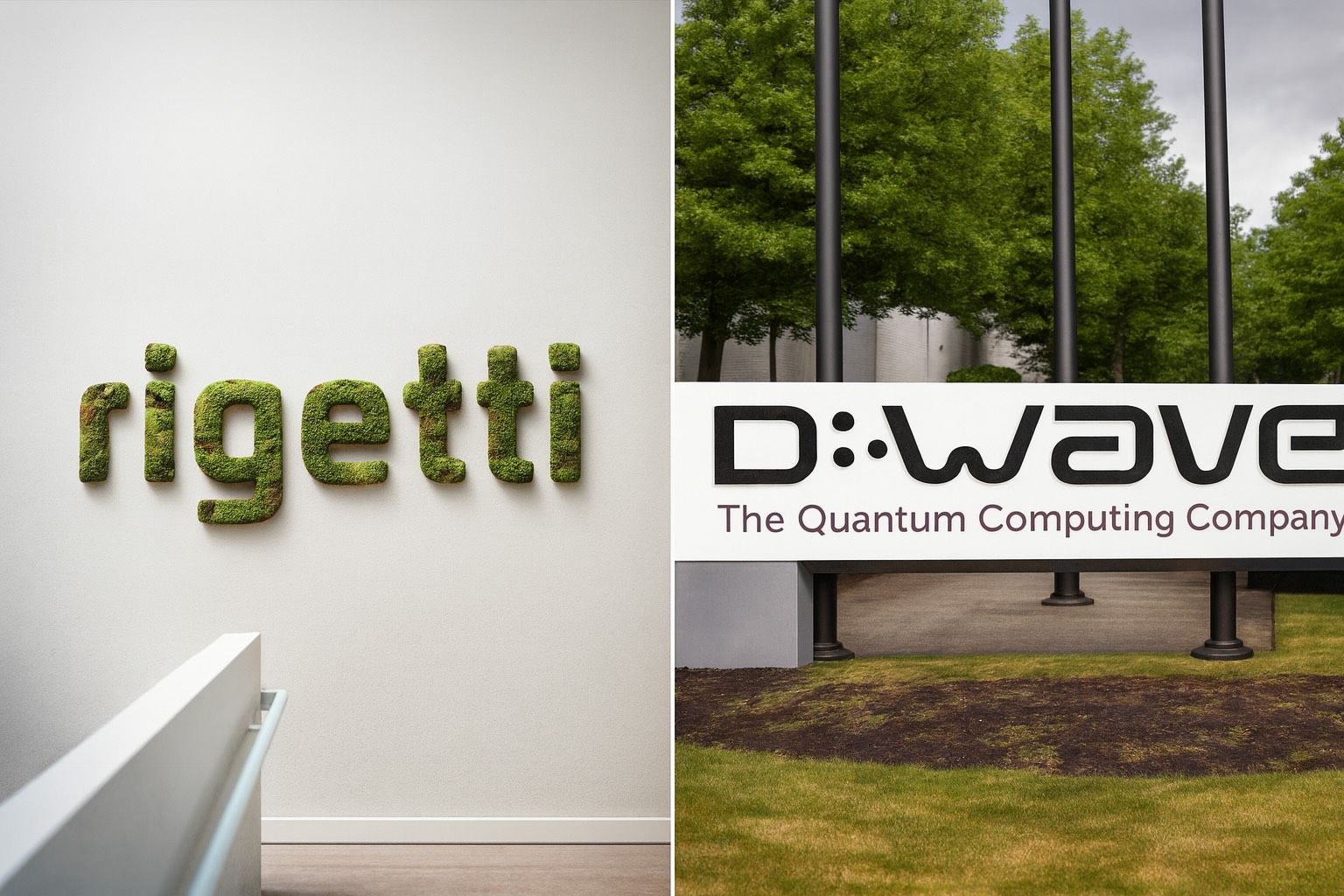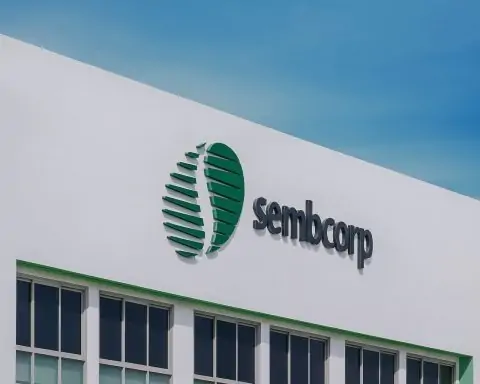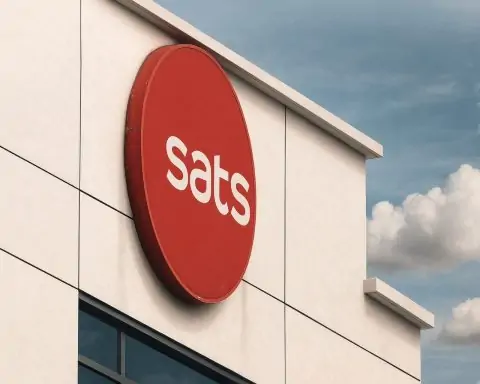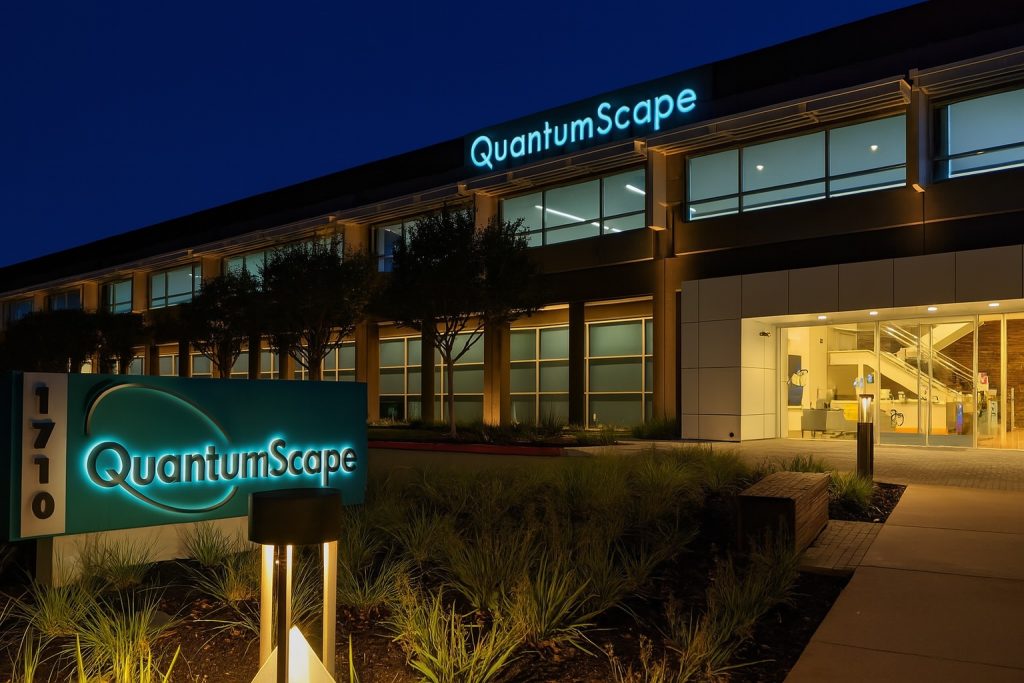- D-Wave (QBTS) – Q2 FY2025 revenue jumped ~42% year-over-year to $3.1 million [1] (on sales of its Advantage2 quantum annealer). The company completed a $400 million ATM equity raise (July 2025) and ended Q2 with a record $819 M cash [2] [3]. Despite revenue growth, GAAP net loss was $167.3 M [4] (mostly due to non-cash warrant charges). D-Wave is rolling out its 6th-generation annealing computer (Advantage2) and expanding globally (e.g. Asia) [5] [6]. However, it trades at a stratospheric price/sales ratio (on the order of hundreds), reflecting high expectations despite lack of profits.
- Rigetti (RGTI) – Q2 FY2025 revenue was $1.8 million with net loss $39.7 M [7]. The company raised $350 M via ATM offerings in Q2, leaving it with about $572 M in cash and no debt [8]. Rigetti introduced its 36‑qubit Cepheus-1-36Q (four 9-qubit chiplets) available on cloud (99.5% 2‑qubit fidelity) and plans a 100+ qubit system by end-2025 [9] [10]. Crucially, Rigetti booked $5.7 M in orders for two 9‑qubit Novera on-prem systems (deliveries in H1 2026) [11], underscoring tangible demand. CEO Subodh Kulkarni noted “increased demand for on‑premises quantum computing systems as the industry matures” [12]. Still, Rigetti’s market cap (~$10–15 B) implies a P/S ratio well over 1000×, making it extremely speculative.
- Market context – All pure-play quantum stocks have seen rocket-like gains in 2025. For example, IonQ, Rigetti, D-Wave and others have “soared” by hundreds or even thousands of percent in the trailing year [13]. This hype reflects belief in a coming quantum revolution, but fundamentals lag. Both companies burn cash with little revenue so far [14] [15]. Analysts warn of extreme valuations: e.g. Motley Fool points out Rigetti trades around a $9 B market cap on negligible sales [16]. In short, investors face a high-risk/high-reward tradeoff – big growth potential against execution and timing risk.
Quantum computing remains an emerging field, and D-Wave and Rigetti represent two very different approaches. D-Wave (NYSE: QBTS) is a veteran in quantum annealing – a specialized model for optimization problems. In mid-2025 the company rolled out its 6th‑generation Advantage2 annealer [17] [18]. Its latest results show solid progress: Q2 2025 revenue of $3.1M (up 42% YOY) and broad customer engagements, but still huge losses. CEO Alan Baratz emphasized the quarter’s achievements: “we brought to market our sixth‑generation quantum computer… ended the quarter with a record $819 million in cash,” and said D-Wave is “confident in our ability to continue delivering long‑term value” [19]. Much of the cash came from a $400M stock offering [20], giving D-Wave one of the strongest war chests among pure‑play quantum companies. The company is investing that capital to scale up – for example, a new cryogenic packaging R&D initiative (with NASA’s JPL) is meant to accelerate both annealing and future gate-based chips toward 100,000-qubit targets [21]. D-Wave is also expanding internationally, holding its first user conference in Japan and seeing an 83% jump in Asia-Pacific bookings over the prior year [22]. These moves diversify its customer base beyond North America and Europe.
However, D-Wave’s revenue remains tiny (millions) relative to its expenses, and it posted a GAAP net loss of $167.3 Min Q2 (much larger than the $3M revenue) [23]. The loss was largely due to non-cash accounting remeasurements of warrants, but even non-GAAP losses are hefty. In short, D-Wave is burning through cash on R&D and expansion. Its price/sales ratio is on the order of several hundred (reflecting sky-high expectations). Some analysts question this valuation. For instance, one Motley Fool writer notes that Rigetti and D-Wave are “trading at close to a $9 billion market cap” (Rigetti’s case) on “very little revenue,” and suggests keeping positions “small” in such speculative names [24]. In other words, while D-Wave has new technology and global partnerships, its stock price assumes near-magical growth. Investors must decide if the brewing demand for quantum annealing (in logistics, materials science, AI) justifies the lofty multiples.
Rigetti Computing (NASDAQ: RGTI), by contrast, has pursued superconducting gate-model quantum computers (more like IBM/Q companies) and a “full-stack” cloud business (QCS platform). Rigetti’s recent headlines have centered on hardware and scaling. In August 2025 it announced the Cepheus-1-36Q – a 36‑qubit system built from four 9‑qubit chiplets – claiming the highest two-qubit fidelity (99.5%) ever reported for a multi-chip processor [25]. CEO Kulkarni called it “the industry’s largest multi-chip quantum computer with impressive performance” [26]. This multi-chip “chiplet” strategy (linking smaller processors) is key to Rigetti’s plan to reach 100+ qubits by year-end [27]. In the cloud era, Rigetti has made Cepheus available on its own QCS platform (and will roll it out on Microsoft Azure) [28], while also preparing on-prem sales of smaller systems.
Indeed, Rigetti just announced two purchase orders (total ~$5.7M) for its 9‑qubit Noverasystems [29]. One customer is an Asian technology manufacturer (building in-house expertise and benchmarking their own tech), and the other is a U.S. AI startup focusing on hardware research [30]. These deals, delivering in H1 2026, reinforce Rigetti’s “hardware‑as‑a‑service” model: it sells systems (including fridge and controls) while also supporting customers via its cloud platform. Kulkarni remarked that as the industry matures, there is “increased demand for on‑premises quantum computing systems” [31]. This is a positive sign – real orders from industry for Rigetti’s full-stack solution – that it is moving beyond pure R&D.
On the financial side, Rigetti’s results show the same pattern of ramped investment. In Q2 2025 the company earned $1.8 M in revenue but lost $39.7 M [32]. (Losses include around $22.8M of non-cash warrant revaluation, much like D-Wave’s.) Rigetti consumed roughly $20M in operating expenses that quarter, accelerating its R&D spend. The good news is its balance sheet: the company completed a $350M ATM raise in Q2 and had $571.6M cash at quarter-end [33]. With no debt, Rigetti can finance its roadmap for now. But as Motley Fool analysts noted, the stock already reflects this cash infusion – Rigetti trades on a price/sales multiple far above 1000× [34]. In the near term its value hinges on showing that these research tools can translate into actual market opportunities.
Comparing the Contenders: D-Wave and Rigetti inhabit the same long-term vision (commercial quantum computing) but very different strategies. D-Wave touts quantum annealing – specialized machines built for optimization problems. Its Advantage2 systems are offered through sales and cloud services, targeting use cases like logistics, finance optimization, and machine learning enhancement. Rigetti, by contrast, builds universal gate-based processors (the same model used by IBM, Google, IonQ etc.), aiming for broader “quantum advantage” down the road. Both companies emphasize their roadmaps: D-Wave on improving annealers and eventually developing gate-model chips (via its packaging initiative [35]), and Rigetti on scaling qubit counts with its chiplet architecture [36].
In terms of traction, D-Wave currently has a larger revenue base (millions vs Rigetti’s low millions) and a more established customer roster (over 100 recurring clients, including GE, Nikon, and the UK’s quantum lab [37] [38]). Rigetti, though younger, is rapidly posting technical milestones (its 36-qubit system is among the industry’s best in fidelity [39]) and now has its first multi-million-dollar orders. Both say they see accelerating demand: D-Wave’s bookings and sign-ups have jumped in Europe and Asia [40], while Rigetti is securing contracts with government labs (recently a ~$5.8M U.S. Air Force research contract [41]) and private firms [42].
Yet neither company is profitable, and neither is likely to be for several years. Analysts stress that real quantum advantage (where these machines outperform classical computers on practical tasks) is still experimental. As Zacks research noted, even with engineering wins D-Wave “will sustain investment and absorb short-term losses” for now [43]. Similarly, Rigetti’s articles emphasize that losses are “an ongoing theme… where commercial demand is still emerging” [44]. In the stock market, this means high volatility. Motley Fool’s Bram Berkowitz wrote on Sept. 22, 2025 that Rigetti’s share price jumped on hype and an analyst upgrade (B. Riley’s Craig Ellis raised the price target after bullish news) [45], but cautioned that “there’s still a lot that needs to happen” and “these stocks trade at close to a $9 billion market cap” on negligible revenue [46].
Investor Takeaways: Put simply, D-Wave and Rigetti exemplify the quantum computing story: revolutionary long-term promise but speculative short-term outlook. Both have some “proofs of progress” – rising revenues, major technical milestones, strong cash positions – yet neither has a clear path to profitability. Investors attracted by the quantum boom should weigh the potential for huge future applications against the reality that commercial revenues remain minuscule. As one analyst advises, expect “big risk, big reward”: if quantum computing takes off, these leaders could soar, but it could be many years before that happens [47].
In sum, D-Wave offers deeper pockets and a commercial track record with its annealing niche, while Rigetti is bullish on its all-purpose, scalable qubits and emerging customer orders. Both stocks have rocketed on optimism, but they also trade at futuristic valuations. Prospective investors for 2026 should monitor upcoming milestones (customer deployments, new system launches, partnerships) and remember that experts urge caution amid the euphoria [48] [49].
Sources: Recent press releases and earnings reports from D-Wave and Rigetti [50] [51] [52] [53], plus market analysis from Nasdaq/Zacks and industry news sites [54] [55] [56]. These detail the companies’ Q2 2025 results, product rollouts, funding rounds, and expert commentary on the quantum-computing sector.
References
1. www.dwavequantum.com, 2. www.dwavequantum.com, 3. www.dwavequantum.com, 4. www.dwavequantum.com, 5. www.dwavequantum.com, 6. www.dwavequantum.com, 7. www.datacenterdynamics.com, 8. thequantuminsider.com, 9. www.datacenterdynamics.com, 10. thequantuminsider.com, 11. thequantuminsider.com, 12. thequantuminsider.com, 13. www.nasdaq.com, 14. www.dwavequantum.com, 15. www.datacenterdynamics.com, 16. www.nasdaq.com, 17. www.dwavequantum.com, 18. www.dwavequantum.com, 19. www.dwavequantum.com, 20. www.dwavequantum.com, 21. www.nasdaq.com, 22. www.nasdaq.com, 23. www.dwavequantum.com, 24. www.nasdaq.com, 25. thequantuminsider.com, 26. thequantuminsider.com, 27. thequantuminsider.com, 28. thequantuminsider.com, 29. thequantuminsider.com, 30. thequantuminsider.com, 31. thequantuminsider.com, 32. www.datacenterdynamics.com, 33. thequantuminsider.com, 34. www.nasdaq.com, 35. www.nasdaq.com, 36. thequantuminsider.com, 37. www.dwavequantum.com, 38. www.dwavequantum.com, 39. thequantuminsider.com, 40. www.nasdaq.com, 41. www.nasdaq.com, 42. thequantuminsider.com, 43. www.nasdaq.com, 44. thequantuminsider.com, 45. www.nasdaq.com, 46. www.nasdaq.com, 47. www.nasdaq.com, 48. www.nasdaq.com, 49. www.nasdaq.com, 50. www.dwavequantum.com, 51. www.dwavequantum.com, 52. www.datacenterdynamics.com, 53. thequantuminsider.com, 54. www.nasdaq.com, 55. www.nasdaq.com, 56. thequantuminsider.com










